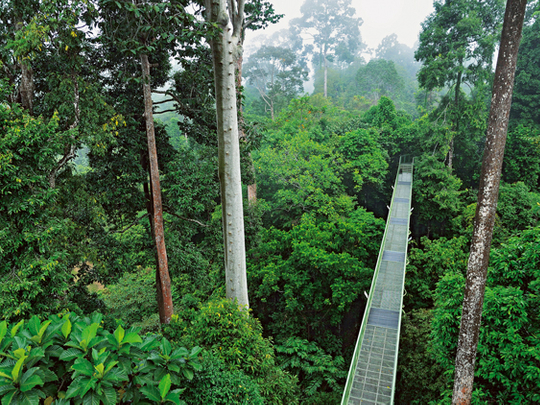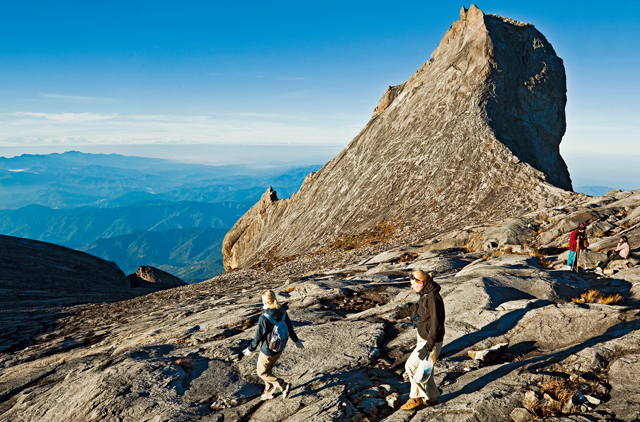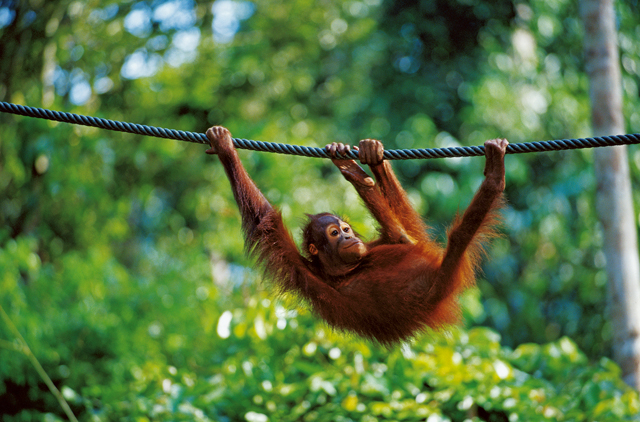
Go diverse
Mount Kinabalu is surrounded by 754 square kilometres of Kinabalu National Park, which, due to its vast biodiversity, is a Unesco World Heritage site. According to Unesco, 93 per cent of the park is natural vegetation and it boasts flowers from more than half of all the species of flowering plants on the planet. There are also more than 300 types of birds and more than 100 different types of mammals. If you’re more into natural splendour than taxonomy, visit Poring – a small town 40 kilometres from Mount Kinabalu – which has natural hot springs, a butterfly park, two waterfalls nearby and a canopy walk in the rainforest treetops, where you walk on rope bridges 20 metres above the forest floor.
Climb the mountain
At 4,095m, Mount Kinabalu is the highest mountain in Borneo and the 20th highest peak in the world. Book yourself on a mountain climb tour, from one to three days. The most popular is the two-day programme: you register at Kinabalu National Park HQ and walk five hours on the first day, via seven resting spots, to the Laban Rata overnight stop. At 2am you start climbing again and race against the sun to make it to the peak before sunrise. After watching the sun come up, you head back down the hill to Laban Rata for breakfast before making the final descent back to the Kinabalu National Park HQ for lunch. Climbing Mount Kinabalu (www.climbingmountkinabalu.com) offers this package for around $300 (Dh1,100), including hotel transfers, mountain guide, climbing permit, accommodation at Laban Rata, five meals and insurance. For the hardcore, there’s an annual climbathon where people from all over the world race to the peak. For more information, visit www.sabahparks.org.my
Find Nemo
There are plenty of postcard-perfect islands off the coast of Sabah where you can splash around in turquoise waters and relax on white sand beaches. If you’re the type who likes to do something at the beach, head to Sapi island. Just a 15-minute speedboat ride away from Kota Kinabalu (the capital of Sabah), Sapi is famous for its sea walking and snorkelling. Sea walking involves donning a heavy helmet with an oxygen pipe running into it and sinking to the bottom of the seabed to watch the fish in their own habitat. It’s basically diving for people who can’t scuba-dive – it’s incredibly easy, not at all scary and hugely enjoyable. There are plenty of tour operators offering day trips to Sapi. Expect to pay around 200 ringgit (Dh235) per person, which includes a boat trip to and from the island and a barbecue lunch.
Cuddle an orangutan
OK, you might not get to actually cuddle one, but just watching these super-cute apes hanging around is a real treat. The Sepilok Orangutan Rehabilitation Centre (orangutan-appeal.org.uk) shelters orphaned orangutans – usually due to deforestation and logging – and orangutans rescued from poachers. In the wild, orangutans stay with their mothers for six years while they learn survival skills before being released into the forest nearby. Day pass to Sepilok costs 30 ringgit (Dh35), which includes two feeding times. For places to stay, the family-friendly Sepilok Jungle Resort is a five-minute walk from the orangutan sanctuary. Visit www.sepilokjungleresort.com
Enter the bat cave
In the rainforest of Sandakan, on the east side of Sabah, the bat-infested Gomantong caves welcome visitors daily to watch the two million bats who inhabit the caves fly in and out at dusk. As if that wasn’t enough, and if you’re into spine-tingling wildlife, there’s plenty around to tickle your fancy including rats, cockroaches, enormous centipedes the size of small mammals and much more. The cave floors are piled high with bat dung, added to every second – sound advice is to wear a hat and avoid looking up. Admission is 30 ringgit (Dh35). Visit sabahtourism.com for details.
Dive with sharks
Diving trips are advertised everywhere in Sabah, but for the best diving, head to Sipadan island. Consistently featured in highly acclaimed ‘best dive site’ lists, Sipadan promises great dives and a high likelihood of seeing hammerheads and other sharks, turtles, manta rays, barracuda and more. There are more than 12 different dive sites off this tiny, tropical island, all of which offer different features, depths and marine life. There have been no resorts on Sipadan since it was declared a protected marine site in 2005, so visitors stay at nearby Mabul island.









